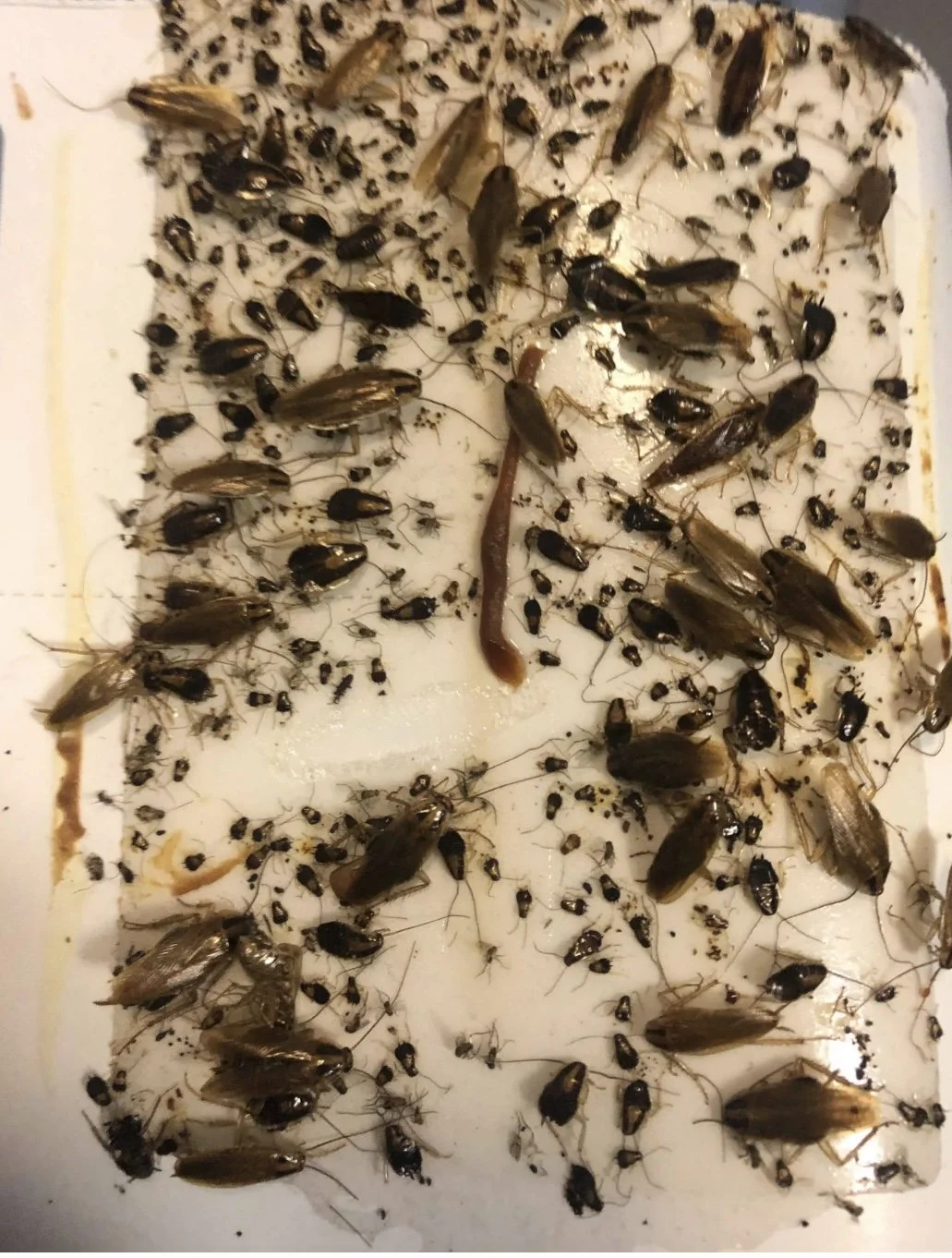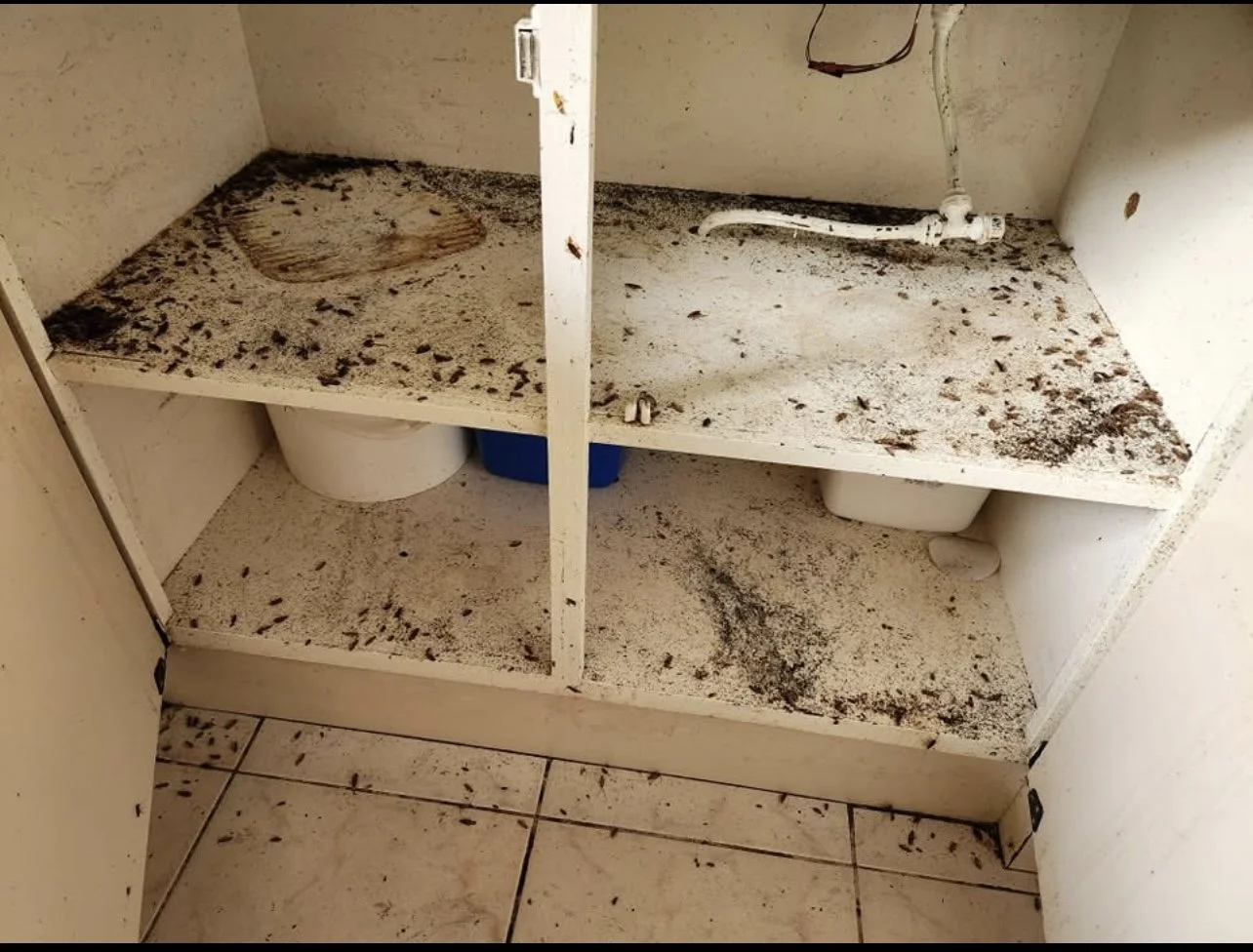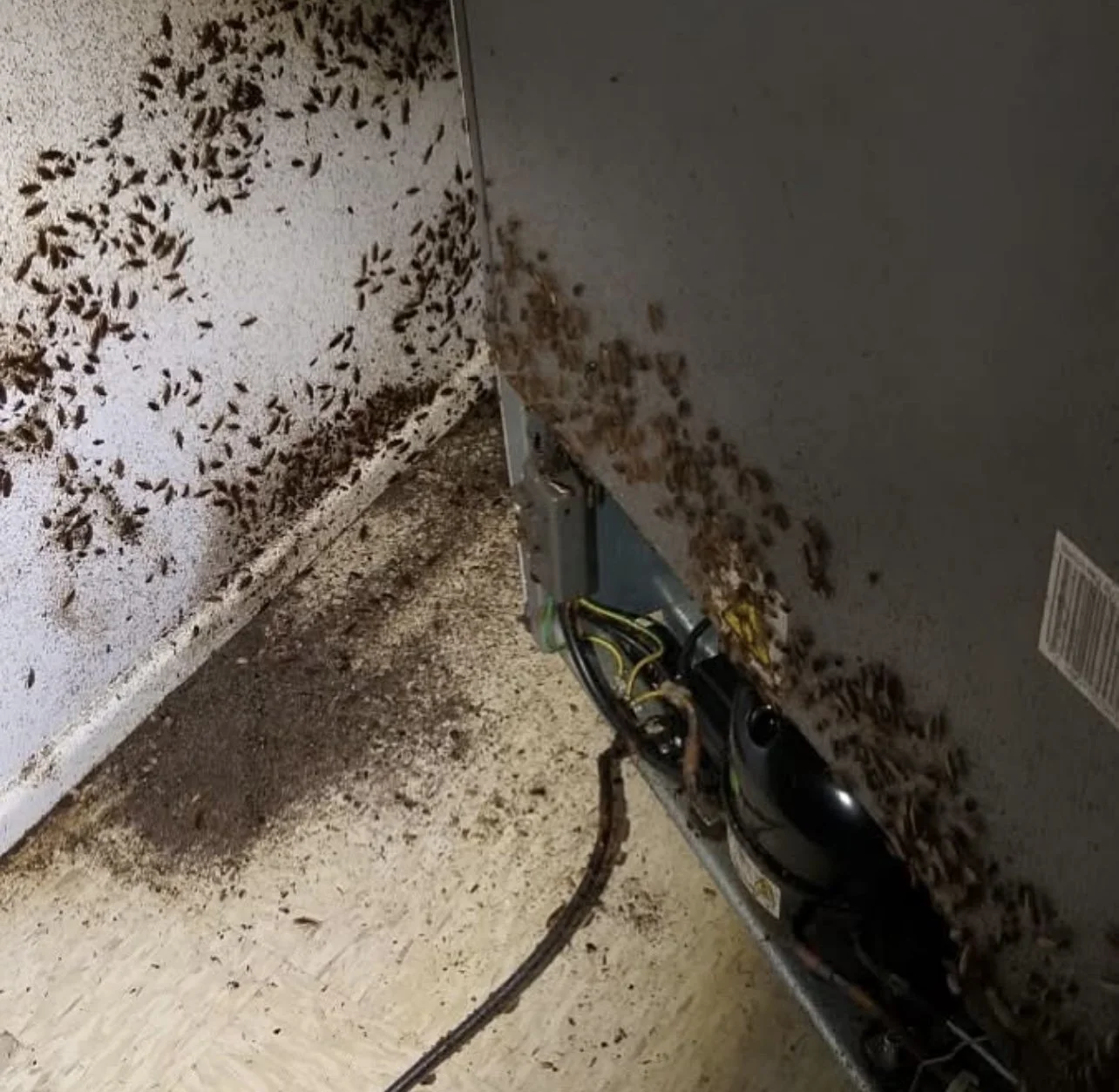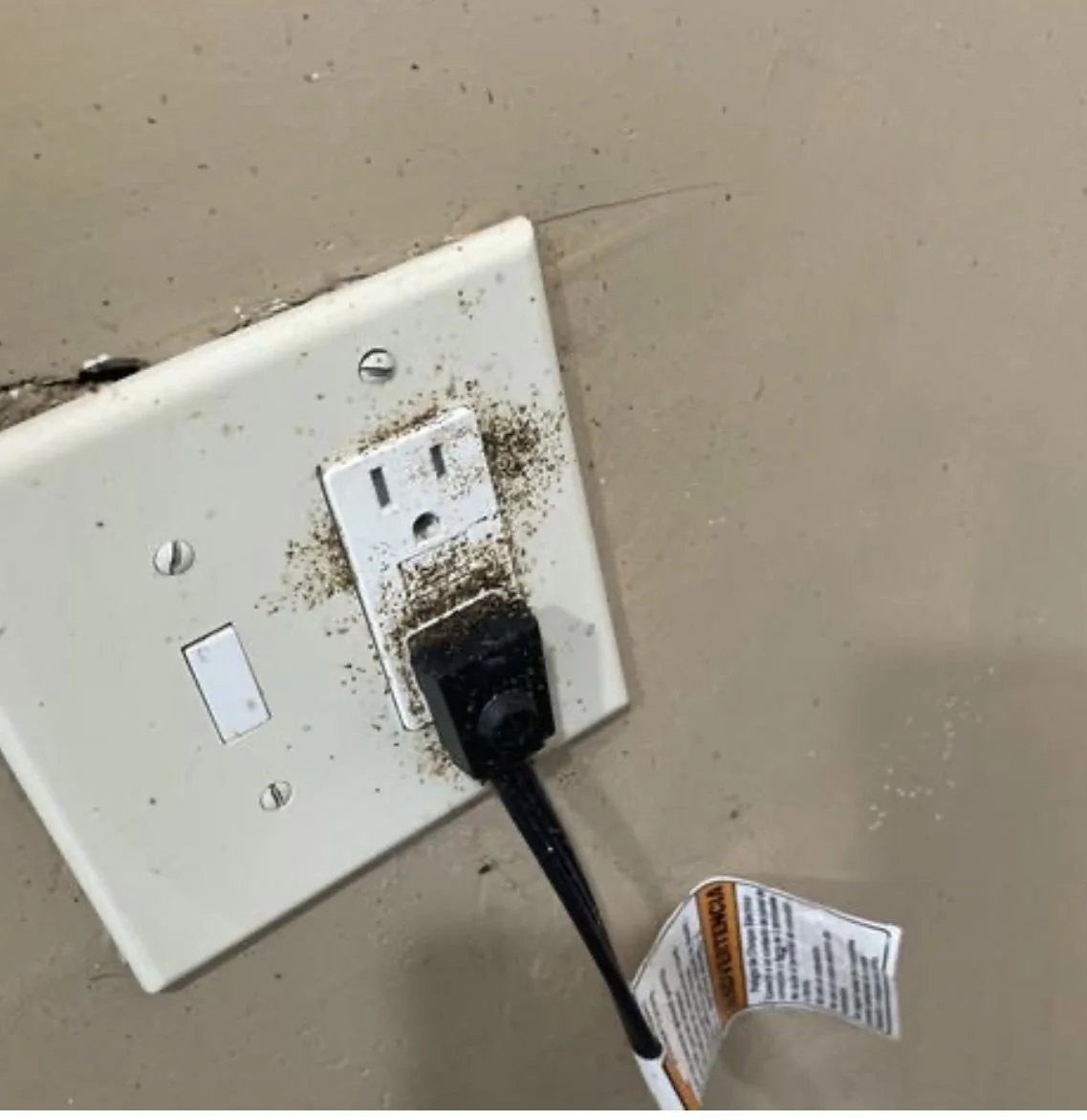
German Cockroach
German Cockroach infestation
German cockroaches prefer to live in warm, humid places close to food and moisture sources. They are frequently found in residential and commercial kitchen environments, and bathrooms, so these are the two most likely places for an infestation to occur. It is also likely to find German cockroach dropping in areas they frequent. Droppings may appear as small, dark, “pepper-like” material left on countertops or in drawers. There may also be fecal staining, which appears as dark spots or smears in the corners of rooms, along the tops of doors or around small cracks and openings into walls.
When German cockroach populations are present in large numbers, it may be possible to detect a mild, somewhat “musty” odor.
German cockroaches show a preference for warm (70°F/21°C) and humid places. They are usually found in residential and commercial kitchens and secondarily in bathrooms. However, a German cockroach infestation can occur in any area where people eat and drink. In homes, this includes dining rooms, living rooms, dens and bedrooms. Any crack of crevice located near a source of food and/or water can harbor cockroaches. German cockroaches can fit through an opening as small as 3/8 inch in width.
German cockroaches are good hitchhikers and often find their way into new structures by hitching a ride in grocery bags, cardboard boxes, drink cartons and secondhand appliances such as refrigerators, televisions, microwaves, etc. They have been observed to migrate from building to building on warm evenings. Although uncommon, they can survive outdoors during the warm months.
German cockroaches have a wide palate. They will feed on almost anything with nutritional value including all kinds of food, as well as soap, glue and toothpaste.
Activity periods for German cockroaches vary greatly with life state, age and physiological state. For example, reproducing females are quite active, whereas males spend the majority of their time in harborage even at night.

During cockroach treatment, pest control professionals will take several steps to ensure the pests are effectively eliminated
.
Initial Reduction
When cockroach control services start, they often use various methods to knock down cockroach numbers quickly. They may employ a combination of insecticide sprays, gel bait, and bait stations.
The initial application targets adult roaches and disrupts their breeding. This quick reduction usually occurs within a few days since the chemicals directly affect the active roaches.
Bait Impact
The domino effect highlights how roach baits work over time. After roaches consume the bait, they carry it back to their nests. This process helps eliminate not just the individual roach but others within the nest, including nymphs (young adults).
Potential for Increased Activity
During treatment, an initial increase in roach activity can be noticed. As roaches begin to consume the bait and relocate to avoid insecticides, they may become more visible in your living spaces.
This phenomenon can be surprising but indicates that the treatment is beginning to work.
Follow-Up Treatments
Follow-up treatments are crucial for ensuring the complete elimination of a cockroach infestation. They are usually scheduled weeks after the initial application to address any surviving American or German roaches or new hatchlings from egg cases.
These follow-ups help break the breeding cycle and ensure the infestation does not return.
How To Maintain a Roach-Free Environment
To maintain a roach-free environment in your home, follow these essential preventive stepsfor cockroach control:
Seal Entry Points: Use caulk to seal crevices, especially around baseboards and walls. Inspect doors and windows for any gaps.
Eliminate Hiding Places: Reduce clutter where roaches can hide. Clear out stacks of paper and cardboard boxes.
Maintain Cleanliness: Clean floors, counters, and other surfaces regularly. Pay extra attention to bathrooms and trash cans for potential food sources.
Fix Leaks: Repair leaking faucets and pipes. To limit attractants, ensure your home remains dry, especially in basements and crawl spaces.
Sprinkle Diatomaceous Earth: Apply food-grade diatomaceous earth lightly in areas where you've seen roaches to kill them by dehydration.
Use Cockroach Bait and Traps: Place bait stations and sticky traps where roaches are commonly seen to monitor new pest activity.
Employ Regular Inspections: Inspect hidden areas, such as behind baseboards and inside voids. Look for signs of cockroach infestations, such as droppings.
Limit Harborage Areas: Fill any gaps and voids in walls and floors. Secure loose wallpaper and repair damaged plaster to remove potential roach habitats.
Seek Professional Help: If the infestation persists, it might be time to call professional pest control services for planned treatment options.
How Long Does It Take to Get Rid of Cockroaches?
Getting rid of cockroaches can be a real headache, and it’s something everyone wants to address as quickly as possible.
Depending on the severity of the cockroach problem and the methods used, it can take anywhere from a few days to several weeks to completely eradicate an infestation.
Are you prepared to find out the most effective ways to kick these pesky invaders out of your home for good? Keep reading to find out the best strategies and make your home cockroach-free.
Key Takeaways
The time it takes to get rid of cockroaches varies with various factors, ranging from a few days to several weeks.
Professional extermination can expedite the process and address large or persistent infestations more effectively than DIY methods.
Preventive measures such as sealing entry points and reducing clutter can help maintain a roach-free environment.
How Long Does It Take to Get Rid of Cockroaches?
While seeing results quickly is possible, completely getting rid of cockroaches can take a few days to several weeks. For a faster and more thorough solution, consider professional pest control.
Essential factors like the size of the infestation, the type of treatment used, and environmental conditions can significantly impact the duration.
Size of the Infestation
The magnitude of a cockroach infestation directly influences the duration of treatment.
Small, localized infestations can often be quickly resolved within days to weeks using simple interventions such as baits or sprays.
Extensive or large infestations require longer-term strategies, potentially spanning several weeks to months.
Home Environment
Environmental factors significantly impact the duration and effectiveness of cockroach eradication efforts. These factors include:
Humidity Levels: Higher humidity supports cockroach survival.
Temperature: Warmth speeds up roach reproduction.
• Food and Water Sources: Readily available food/water sustains the infestation.
German cockroaches are notoriously difficult to kill because they reproduce incredibly fast, can develop resistance to common pesticides, hide in tight spaces, carry their egg cases with them, and are adept at finding food sources, making it hard to completely eliminate them with simple methods; often requiring professional pest control intervention to manage an infestation.
Key reasons why German roaches are hard to kill:
Rapid reproduction:
Female German cockroaches carry their egg cases until they are ready to hatch, producing large numbers of offspring quickly.Pesticide resistance:
Due to their rapid evolution, German roaches can develop resistance to various insecticides over time.Hiding behavior:
They are excellent at finding tiny crevices and tight spaces where pesticides may not reach, making them difficult to target.Adaptability:
German roaches can survive on a wide range of food sources, including crumbs, grease, and even glue, making it hard to starve them out.Tough exoskeleton:
Their hard outer shell provides protection against physical attempts to kill them.





